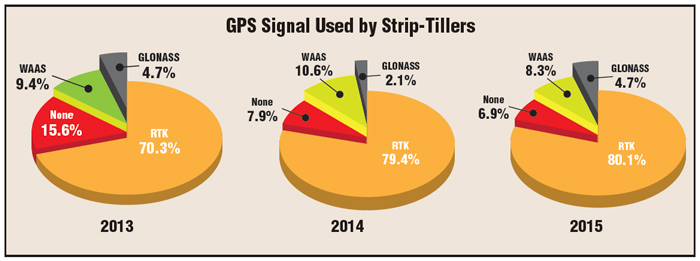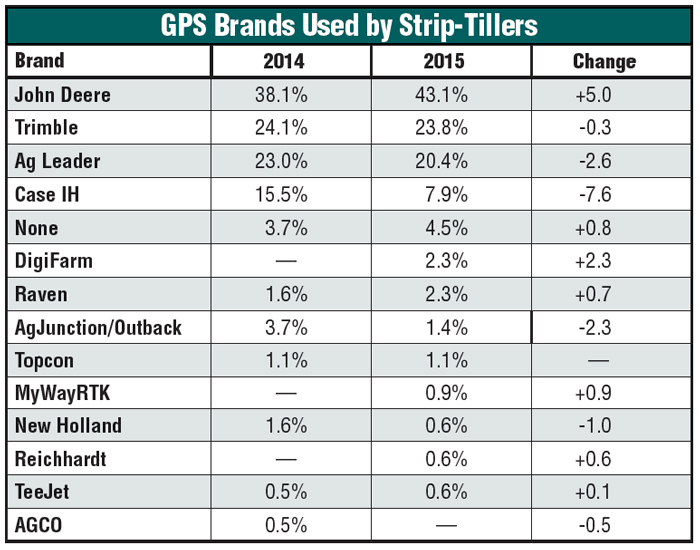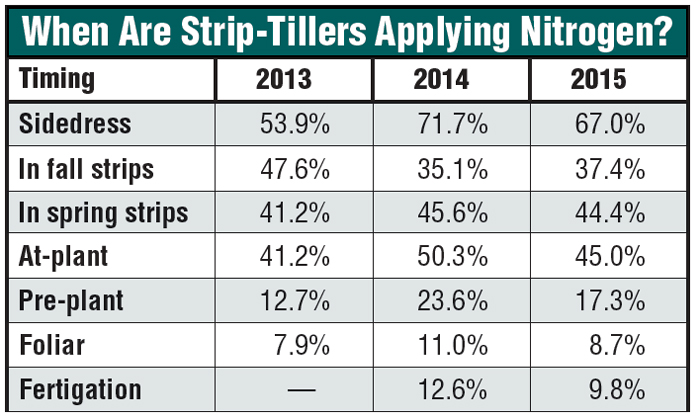Strip-tillers often cite targeted fertilizer placement as a key benefit of the practice, to ensure that plant roots can access nutrients throughout the growing season. But the 3rd Annual Strip-Till Operational Benchmark Study revealed some interesting changes in what type of fertilizer strip-tillers are applying and how.
The number of respondents who band fertilizer in the strip dropped about 8 percentage points, from 74.2% in 2014 to 66% last year. Countering this decline was about a 9-point increase in the number of strip-tillers who mixed fertilizer into the berm, from 28.5% in 2014 to 37.3% last year.
Also seeing an increase, albeit a minor one, was the percentage of farmers who apply fertilizer between the berms with their strip-till rig, from 4% in 2014 to 5.3% last year.
While a smaller number of strip-tillers banded fertilizer beneath the strip, they maintained an average depth of 6 inches, consistent with last year’s result. Some strip-tillers banded fertilizer as shallow as 1-2 inches, while others went as deep as 10-12 inches.
Last year, more strip-tillers utilized a dry fertilizer box, with 61.7% using a mounted- or pull-type box, compared to 56% in 2014 and 57.9% in 2013.
Timing Nitrogen Applications
Feeding the crop on a consistent basis throughout the growing season often requires multiple fertilizer applications, and strip-tillers tend to efficiently time their nitrogen (N) based on need.
But last year, fall N placement in the strips was the only method that saw a year-over-year increase among strip-till survey respondents, from 35.1% in 2014 to 37.4% last year.
The biggest declines were seen with pre-plant N applications, from 23.6% in 2014 to 17.3% last year, and those who made at-plant N applications, from 50.3% to 45%. The most popular method of N application by strip-tillers was again sidedressing, but this percentage dropped to 67% in 2015, from 71.7% in 2014.
There were also smaller declines in the number of strip-tillers making foliar N applications, from 11% in 2014 to 8.7% last year, and fertigation of N, from 12.6% to 9.8%. These came a year after near across-the-board increases of strip-till N applications from 2013-14.
As for the types of N that farmers are applying with their strip-till rigs, anhydrous ammonia was again the most popular, with 30.6% using this source. However, this represented a nearly 9 point drop off from 2014.
Increasing governmental regulatory pressures in many areas may have contributed to the decline, but it will be interesting to see if the trend continues in coming years, given that anhydrous is still an economical source of N.
For the second year in a row, fewer farmers applied liquid N, with 19.1% choosing this source on their strip-till unit, compared to 22.4% in 2014 and 32.1% in 2013. However, urea application increased by about 10 points year-over-year, from 15.3% to 25.6%.

On the MAP
Once again the majority of strip-tillers prefer to make their phosphorus (P) and potassium (K) applications with their strip-till rig than at any other time of the season. More than 97% of survey respondents apply P and K either in fall strips (59.7%) or in spring strips (37.7%). These applications were up from 55.3% and 34.8% in 2014, respectively.
Looking at the most common forms of K applied with the strip-till rig, 55.6% of farmers applied potash in 2015, compared to 57.1% in 2014 and 44.6% in 2013. The number of strip-tillers making K chloride applications rebounded to 7.5% in 2015, which had dropped to 4.1% in 2014 after starting out at 7.1% in 2013.
Monoammonium phosphate (MAP) was the biggest mover among P sources applied by strip-tillers, with 36.3% using this fertilizer in 2015, vs. 30.6% in 2014 and 23.2% in 2013.
Diammonium phosphate (DAP) was the second most popular source, applied by 32.2% of strip-tillers in 2015, on par with 2014 (32.9%) and 2013 (33.9%).

Evaluating micronutrient applications with the strip-till rig, zinc had the most significant drop to 29.4% in 2015, compared to 35.5% in 2014. Boron also declined to 9.7% from 12.9% in 2014, while sulfur remained the same and was the most popular micronutrient at 37.8%.
Variable-Rate Rise
Although there is still some debate over the consistent benefits of variable-rate fertilizer application, it’s a practice that strip-tillers continue to embrace.
Use increased in 2015 to 43.2% of respondents, up from 36.2% in 2014 and 31.5% in 2013. With farmers continuing to manage fertilizer costs, this will be a trend worth watching in the coming years.
Use of RTK-level GPS correction for strip-till operations remained consistent, with 80.1% of respondents choosing this level of accuracy, compared to 79.4% in 2014 and 70.3% in 2013. Fewer strip-tillers don’t use any type of guidance, according to this year’s study at 6.9%, down from 7.9% and 15.6% for the prior 2 years, respectively.
Looking at the most popular brands of GPS systems, John Deere was again the top choice, with 43.1% using the manufacturer’s system, up from 38.1% in 2014. Trimble held the second spot at 23.8%, near the 24.1% total from 2014, and Ag Leader was third at 20.4%, down from 23%.
The biggest decline came in the number of strip-tillers using Case IH’s GPS at 7.9% in 2015 from 15.5% in 2014.
Once again, fewer strip-tillers used implement guidance in 2015, with 17.8% utilizing the technology, down from 19.7% in 2014 and 20.3% in 2013.
View from the Top
Banding fertilizer beneath the berm has remained the most common method among the top-yielding strip-tillers, with 80% preferring this method, nearly identical to the 79.3% in 2014.

Some 28% mixed fertilizer into the strip in 2015, an increase over the 19.5% who did so in 2014.
The most popular application method for N was again sidedressing (50%), although this was 20 points lower than in 2014. The second most common method was banded application in spring strips (46.9%), followed by banded application in fall strips (28.1%), down more than 25 points from 2014.
Only 30% of the top strip-tillers applied anhydrous ammonia in 2015, less than half the number in 2014 (62.5%). Some 30% applied liquid N with their strip-till rig, double the number of 2014.
This group also applies the majority of their P and K in spring strips, with 48.3% preferring this method, up from 37.8% in 2014. Another 44.9% apply their P and K in the fall strips, down from 59.5% who did so in 2014.
MAP is the most popular form of P applied by strip-tillers, with 48.3% using this fertilizer, up from 31.7% in 2014. Potash was applied by 30% of respondents, down from 41.5% the prior year.
A slightly higher percentage of the top-yielding strip-tillers used variable-rate fertilizer at 46.4%, and 93.7% utilized RTK-level GPS correction.
Consistent with the overall group, John Deere was the most commonly used brand of GPS, with 61.3% of the top strip-tillers using the system. Implement guidance use was up slightly among the top strip-tillers, with 21.9% utilizing the technology, compared to 17% in 2014.






